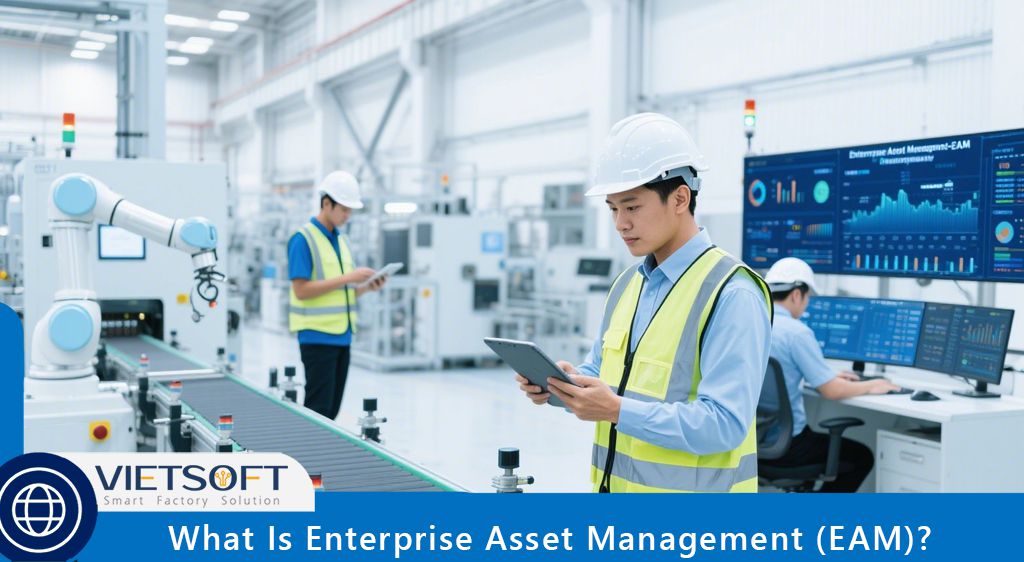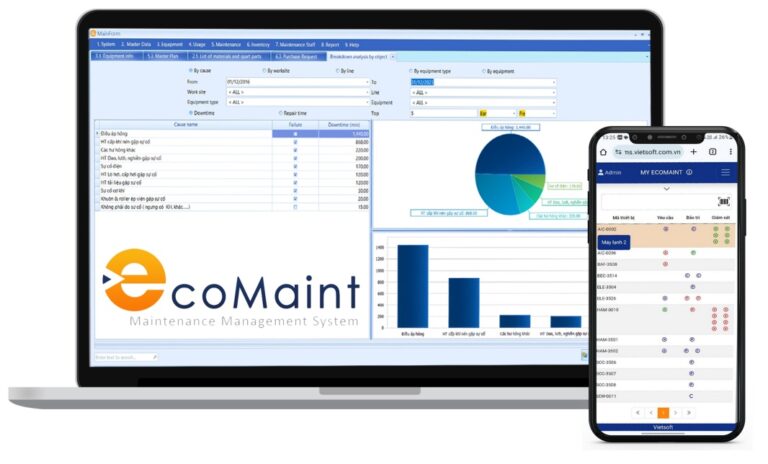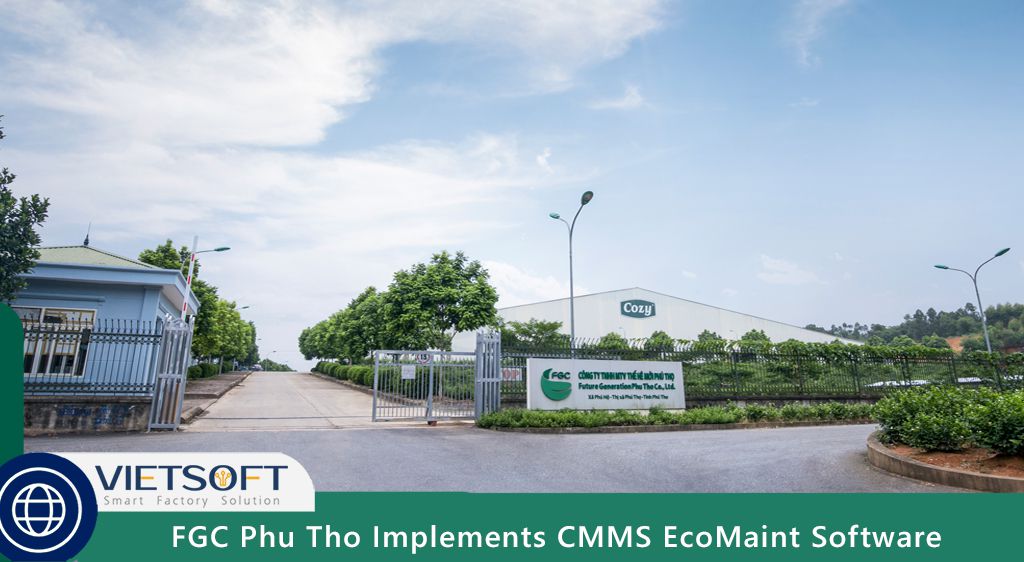
Enterprise Asset Management (EAM) is a critical discipline for organizations that rely on physical assets to drive their operations. From manufacturing plants to transportation fleets, EAM ensures that assets are optimized for performance, reliability, and cost-efficiency throughout their lifecycle. This guide dives deep into the concept of EAM, its key features, benefits, applications.
I. Understanding Enterprise Asset Management (EAM)
Enterprise Asset Management (EAM) refers to the strategic process of managing an organization’s physical assets—such as machinery, vehicles, infrastructure, and facilities—across their entire lifecycle, from acquisition to disposal. By leveraging software, systems, and services, EAM optimizes asset performance, minimizes downtime, reduces operational costs, and ensures compliance with safety and regulatory standards.
Unlike traditional asset management, which may focus solely on financial assets, EAM encompasses the holistic management of physical assets. It integrates advanced technologies like the Internet of Things (IoT), artificial intelligence (AI), and cloud computing to provide real-time insights, enabling organizations to make data-driven decisions that enhance efficiency and sustainability.
II. Key Objectives of EAM
- Maximize Asset Lifespan: Extend the operational life of assets through proactive maintenance.
- Reduce Costs: Optimize maintenance schedules and inventory to lower operational expenses.
- Enhance Uptime: Minimize unplanned downtime to ensure continuous production.
- Ensure Compliance: Meet regulatory and safety standards to avoid penalties.
- Improve Decision-Making: Use data analytics to inform strategic asset management decisions.
III. The Evolution of Enterprise Asset Management
EAM has evolved significantly over the decades, driven by technological advancements and the growing complexity of industrial operations.
1. From Manual to Digital Systems
In the 1960s, asset management relied heavily on manual processes, such as paper-based records and physical inspections. Maintenance teams used punch cards and bulky folders to track equipment performance, which was prone to errors and inefficiencies. The introduction of Computerized Maintenance Management Systems (CMMS) in the 1980s marked a turning point, digitizing maintenance tasks and improving accuracy.
2. The Rise of Comprehensive EAM Solutions
As businesses expanded and asset portfolios grew, the limitations of CMMS became apparent. While CMMS focused primarily on maintenance tasks, EAM emerged as a broader solution, encompassing the entire asset lifecycle. Modern EAM systems integrate with IoT, AI, and cloud technologies, enabling predictive maintenance, real-time monitoring, and seamless data sharing across departments.
3. The Future of EAM
In 2025, EAM is poised to leverage emerging technologies like machine learning, digital twins, and 5G connectivity. These advancements allow for more precise asset monitoring, predictive analytics, and remote management, aligning with the principles of Industry 5.0, which emphasizes human-machine collaboration and sustainability.
IV. EAM vs. CMMS: Key Differences
While EAM and CMMS are often mentioned together, they serve distinct purposes. Understanding their differences is crucial for organizations choosing the right solution.
1. Scope and Functionality
- CMMS: Focuses on maintenance management, including work order creation, preventive maintenance scheduling, and inventory tracking. It is ideal for organizations with straightforward maintenance needs.
- EAM: Encompasses the entire asset lifecycle, from procurement to disposal. It includes advanced features like financial management, supply chain integration, and compliance tracking, making it suitable for asset-intensive organizations with complex operations.
2. Integration Capabilities
- CMMS: Typically integrates with maintenance-specific tools but lacks the broad interoperability required for enterprise-wide systems.
- EAM: Seamlessly integrates with Enterprise Resource Planning (ERP) systems, supply chain management tools, and financial platforms, ensuring a unified approach to asset management.
3. Target Users
- CMMS: Best suited for small to medium-sized businesses or facilities with a maintenance-centric focus.
- EAM: Ideal for large organizations with diverse asset portfolios, such as manufacturing, utilities, or transportation networks.
IV. Why Enterprise Asset Management Is Critical
EAM is vital for organizations that depend on physical assets to deliver products or services. Assets—whether they are production equipment, vehicles, or infrastructure—represent significant capital investments. Effective EAM ensures these investments deliver maximum value while minimizing risks and costs.
V. Key Benefits of EAM
· Extended Asset Lifespan: By implementing preventive and predictive maintenance, EAM extends the usability of assets, delaying costly replacements.
· Reduced Downtime: Real-time monitoring and predictive analytics help identify issues before they cause unplanned outages.
· Cost Savings: Optimized maintenance schedules and inventory management reduce unnecessary expenses.
· Improved Compliance: Centralized documentation and audit trails ensure adherence to safety and regulatory standards.
· Enhanced Decision-Making: Data-driven insights enable informed decisions about asset maintenance, upgrades, and replacements.
· Sustainability: EAM supports energy-efficient operations and reduces waste, contributing to environmental goals.
For instance, a food processing plant using EAM can monitor refrigeration units in real time, preventing spoilage and ensuring compliance with food safety regulations, ultimately saving costs and enhancing customer satisfaction.
VI. Core Features of Effective EAM Systems
Modern EAM systems are equipped with a suite of features designed to streamline asset management and drive operational excellence. Below are the key components that make EAM solutions effective.
1. Work Order Management
EAM systems simplify the creation, assignment, and tracking of work orders. Technicians can access work orders via mobile devices, update progress in real time, and close tasks efficiently. For example, a maintenance technician can receive a work order to repair a conveyor belt, access its maintenance history, and log the repair details—all within the EAM platform.
2. Asset Lifecycle Management
EAM tracks assets from procurement to decommissioning, providing a comprehensive view of their performance, maintenance history, and costs. This ensures assets are utilized optimally and replaced at the right time.
3. Predictive and Preventive Maintenance
EAM systems use IoT sensors and AI to predict equipment failures before they occur. By analyzing data such as vibration, temperature, or runtime, EAM enables maintenance teams to schedule repairs proactively, reducing downtime.
4. Inventory and Supply Chain Management
EAM integrates with supply chain systems to manage Maintenance, Repair, and Operations (MRO) inventory. It tracks spare parts, monitors stock levels, and automates reordering to prevent shortages.
5. Health, Safety, and Compliance
EAM systems document safety incidents, track compliance with regulations, and provide audit trails. This reduces the risk of penalties and ensures a safe working environment.
6. Mobile Accessibility
Mobile-enabled EAM systems allow technicians to access asset data, work orders, and manuals from anywhere. This is particularly valuable for field service teams or multi-site operations.
7. Analytics and Reporting
EAM systems provide dashboards and reports to monitor Key Performance Indicators (KPIs) such as asset uptime, maintenance costs, and energy consumption. These insights help managers identify trends and optimize operations.
8. Cloud-Based Deployment
Cloud-based EAM solutions offer scalability, flexibility, and reduced IT overhead. They allow organizations to access the system remotely, receive automatic updates, and integrate with other cloud-based platforms. This is ideal for businesses with distributed operations, such as utilities or transportation companies.
VII. Applications of EAM Across Industries
EAM is a versatile solution that benefits a wide range of industries. Below are some examples of how EAM is applied in various sectors.
1. Manufacturing
In manufacturing, EAM optimizes production equipment, reduces downtime, and integrates with Lean Six Sigma methodologies. For example, an automotive manufacturer can use EAM to monitor assembly line machines, ensuring they operate at peak efficiency and minimizing production delays.
2. Energy and Utilities
EAM manages linear assets like pipelines and power lines, as well as complex crew scheduling. For instance, a utility company can use EAM to track the condition of transformers and schedule maintenance to prevent power outages.
3. Transportation
EAM ensures the reliability of fleets, tracks fuel consumption, and manages spare parts inventory. A logistics company can use EAM to monitor truck maintenance schedules, reducing breakdowns and improving delivery times.
4. Healthcare
EAM tracks medical equipment, ensures compliance with health regulations, and monitors facility conditions. For example, a hospital can use EAM to manage MRI machines, ensuring they are maintained regularly to avoid disruptions in patient care.
5. Oil and Gas
EAM integrates safety, compliance, and performance management for assets like pipelines and drilling equipment. An oil refinery can use EAM to monitor equipment health, reducing the risk of environmental incidents.
6. Food and Beverage
EAM ensures food safety by monitoring equipment like ovens and refrigeration units. A beverage manufacturer can use EAM to track the condition of bottling machines, preventing contamination and ensuring regulatory compliance.
VIII. The Role of EAM in Sustainability
In 2025, sustainability is a top priority for businesses. EAM contributes to environmental goals by optimizing energy usage, reducing waste, and extending asset lifespans. For example, an EAM system can monitor a factory’s energy consumption, identifying inefficiencies and recommending adjustments to reduce the carbon footprint. By minimizing unplanned downtime and optimizing maintenance, EAM also reduces the need for frequent replacements, further supporting sustainability.
IX. Challenges in Implementing EAM
While EAM offers significant benefits, its implementation can present challenges. Addressing these proactively ensures a smooth transition.
1. Employee Resistance
New systems can disrupt established workflows, leading to resistance from employees. Comprehensive training and clear communication about the benefits of EAM can mitigate this issue.
2. Data Migration
Migrating data from legacy systems to an EAM platform can be complex, especially if records are incomplete. Conducting a thorough data audit and working with an experienced vendor can streamline the process.
3. Choosing the Right Vendor
Selecting an EAM solution that aligns with an organization’s needs requires careful evaluation. Businesses should prioritize vendors with strong support, scalability, and integration capabilities.
X. How CMMS EcoMaint Enhances Enterprise Asset Management
For organizations in Vietnam seeking a robust EAM solution, CMMS EcoMaint from Vietsoft offers a powerful, user-friendly platform tailored to the needs of asset-intensive industries. EcoMaint combines the strengths of traditional CMMS with advanced EAM features, providing a comprehensive solution for managing assets across their lifecycle.
Why Choose CMMS EcoMaint?
- Real-Time Asset Monitoring: EcoMaint integrates with IoT sensors to provide real-time insights into asset health, enabling predictive maintenance and reducing downtime.
- Mobile Accessibility: Technicians can access work orders, manuals, and reports on mobile devices, improving efficiency in the field.
- Seamless Integration: EcoMaint connects with ERP and financial systems, ensuring data consistency across departments.
- Customizable Dashboards: Managers can track KPIs and generate reports tailored to their needs, enhancing decision-making.
- Localized Support: Designed with the Vietnamese market in mind, EcoMaint offers local support and compliance with regional regulations.
By implementing CMMS EcoMaint, businesses can streamline maintenance processes, optimize asset performance, and achieve significant cost savings. Learn more about CMMS EcoMaint here.
Contact us for consultation via hotline: 0986778578 or email: sales@vietsoft.com.vn.
XI. Future Trends in Enterprise Asset Management
As technology continues to evolve, EAM is set to become even more sophisticated. Key trends to watch in 2025 include:
- Digital Twins: Virtual replicas of physical assets enable real-time monitoring and scenario testing.
- AI-Driven Predictive Analytics: Advanced algorithms predict failures with greater accuracy, optimizing maintenance schedules.
- 5G Connectivity: Faster data transfer enhances real-time asset monitoring and remote management.
- Sustainability Focus: EAM systems will increasingly prioritize energy efficiency and carbon footprint reduction.
XII. Conclusion
Enterprise Asset Management (EAM) is a transformative approach to managing physical assets, enabling organizations to maximize performance, reduce costs, and ensure compliance. By integrating advanced technologies like IoT, AI, and cloud computing, EAM systems provide real-time insights and proactive maintenance strategies that drive operational excellence. Solutions like CMMS EcoMaint from Vietsoft empower businesses in Vietnam to achieve these benefits, offering a tailored, scalable platform for asset-intensive industries.
Whether you’re a maintenance manager, technician, or business leader, EAM can revolutionize how you manage assets, delivering long-term value and sustainability. Explore the potential of EAM with CMMS EcoMaint and take the first step toward smarter asset management today.




